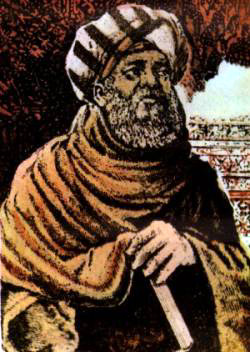<Back to Index>
- Mathematician and Physician Al-Ṣābi' Thābit ibn Qurra al-Ḥarrānī, 826
PAGE SPONSOR

Al-Ṣābiʾ Thābit ibn Qurra al-Ḥarrānī (Arabic: ثابت بن قرة, Latin: Thebit/Thebith/Tebit; 826 – February 18, 901) was a mathematician, physician, astronomer and translator of the Islamic Golden Age.
Ibn Qurra made important discoveries in algebra, geometry and astronomy. In astronomy, Thabit is considered one of the first reformers of the Ptolemaic system, and in mechanics he was a founder of statics.
Thabit was born in Harran (known as Carrhae in antiquity) in Higher Mesopotamia / Assyria (in modern day Turkey). At the invitation of Muhammad bin Musa bin Shakir, one of the Banu Musa brothers, Thabit went to study in Baghdad at the House of Wisdom. He was an ethnic Assyrian, a native Syriac / Aramaic speaker, and belonged to the Sabians of Harran, a sect of Hermeticists. Other sources credit him to be a Mandaean. In either case, both sects have a great interest in astronomy, astrology, and mathematics (especially in the case of Mandaeans).
The Sabians lived in the vicinity of the main center of the Caliphate until 1258, when the Mongols destroyed their last shrine. During Muslim rule, they were a protected minority, and around the time of al-Mutawakkil's reign Harran became a center for philosophical, esoteric, and medical learning. They may have been joined by the descendants of pagan Greek scholars who, not tolerated in the Byzantine Empire, settled in lands that became part of the Abbasid caliphate. After 750 AD, some Muslim rulers and scholars became interested in Greek sciences, collecting and having translated many ancient Greek works in the fields of philosophy and mathematics. Although they later became Arabic speakers, in pre - Islamic times, it was common for Sabians to speak Greek.
Thabit and his pupils lived in the midst of the most intellectually vibrant, and probably the largest, city of the time, Baghdad. He occupied himself with mathematics, astronomy, astrology, magic, mechanics, medicine, and philosophy. Later in his life, Thabit's patron was the Abbasid Caliph al-Mu'tadid (reigned 892 – 902). Thabit became the Caliph's personal friend and courtier.
Thabit died in Baghdad. After him the greatest Sabean name was Abu Abdallah Mohammad ibn Jabir Al-Battani. Thabit and his grandson Ibrahim ibn Sinan ibn Thabit studied the curves needed for making sundials. Thabit's son Sinan ibn Thabit was a distinguished physician who was responsible for supervising all the public hospitals of Baghdad. He was a member of the Sabian sect.
Thabit's native language was Syriac, which was the eastern Aramaic dialect from Edessa, and he knew Greek well too. He translated from Greek Apollonius, Archimedes, Euclid and Ptolemy. Thabit had revised the translation of Euclid's Elements of Hunayn ibn Ishaq. He also rewrote Hunayn's translation of Ptolemy's Almagest and translated Ptolemy's Geography. Thabit's translation of a work by Archimedes which gave a construction of a regular heptagon was discovered in the 20th century, the original having been lost.
The medieval astronomical theory of the trepidation of the equinoxes is often attributed to Thabit. But it had already been described by Theon of Alexandria in his comments of the Handy Tables of Ptolemy. According to Copernicus Thabit determined the length of the sidereal year as
365 days, 6 hours, 9 minutes and 12 seconds (an error of 2 seconds).
Copernicus based his claim on the Latin text attributed to Thabit.
Thabit published his observations of the Sun.
In mathematics, Thabit discovered an equation for determining the amicable numbers. He also wrote on the theory of numbers, and extended their use to describe the ratios between geometrical quantities, a step which the Greeks never took.
He is known for having calculated the solution to a chessboard problem involving an exponential series.
In physics, Thabit rejected the Peripatetic and Aristotelian notions of a "natural place" for each element. He instead proposed a theory of motion in which both the upward and downward motions are caused by weight, and that the order of the universe is a result of two competing attractions (jadhb): one of these being "between the sublunar and celestial elements", and the other being "between all parts of each element separately".
Only a few of Thabit's works are preserved in their original form. Among them On the Sector - Figure which deals with Menelaus' theorem and On the Composition of Ratios.